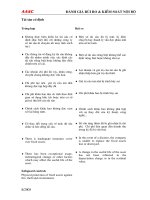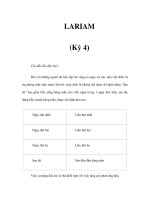Ví dụ một số loại rủi ro
Bạn đang xem bản rút gọn của tài liệu. Xem và tải ngay bản đầy đủ của tài liệu tại đây (65.35 KB, 12 trang )
AASC
Đánh giá rủi ro & Kiểm soát nội bộ
Tài sản cố định
Trờng hợp Rủi ro
Không thực hiện kiểm kê tài sản cố
định (đặc biệt đối với những công ty
có tài sản di chuyển nh máy tính xách
tay).
Các thông tin về đăng ký tài sản không
đầy đủ nhằm tránh việc xác định các
tài sản riêng biệt hoặc không đợc điều
chỉnh trên sổ cái.
Các khoản chi phí lãi vay, nhân công,
chi phí chung không đợc vốn hoá.
Chi phí tạo nên giá trị của toà nhà
không đợc tập hợp đầy đủ
Chi phí khấu hao đợc ớc tính theo thời
gian sử dụng hữu ích hoặc trên cơ sở
giá trị thu hồi của tài sản
Chính sách khấu hao không đợc xem
xét lại hàng năm.
Có thay đổi trọng yếu về mức độ sửa
chữa và bảo dỡng tài sản.
There is inadequate insurance cover
over fixed assets.
There has been exceptional usage,
technological change or other factors
which may affect the useful life of the
asset.
Safeguard controls
Physical protection of fixed assets against
fire, theft and environment.
Một số tài sản đã bị mất, bị điều
chuyển hay thanh lý vẫn đợc phản ánh
trên sổ kế toán.
Một số tài sản riêng biệt không thể xác
định riêng biệt hoặc không tồn tại.
Lợi nhuận và giá trị của tài sản bị ghi
nhận thấp hơn giá trị cần thiết.
Giá trị của toà nhà bị trình bày sai
Chi phí khấu hao bị trình bày sai
Chính sách khấu hao không phù hợp
với sự thay đổi của kỹ thuật, công
nghệ...
Số vốn tăng thêm đã bị ghi nhận là chi
phí. Chi phí liên quan đến doanh thu
trong kỳ đã bị vốn hoá.
In the event of a disaster, the company
is unable to replace the fixed assets
lost or destroyed.
A change in the useful life of the asset
has not been reflected in the
depreciation charge or in the residual
value.
8/2005
AASC
§¸nh gi¸ rñi ro & KiÓm so¸t néi bé
8/2005 Trang 2
/ 12
AASC
§¸nh gi¸ rñi ro & KiÓm so¸t néi bé
INTANGIBLE FIXED ASSETS
Condition Possible reasons/risks
♦ Substantial acquisition activity exists.
♦ The client has commenced valuing
brand names and other intangibles in
the balance sheet.
♦ The recoverability of intangible assets
is not subject to regular evaluation.
♦ Large amounts of research and
development expenditure are
undertaken.
♦ Failure to identify intangible assets
when the purchase method of
accounting for business combinations
is applied.
♦ There may be insufficient evidence to
justify the valuation of the brand.
♦ Failure to recognise the need for or to
account for write downs or to adjust
the amortisation period.
♦ Research and development
expenditure is incorrectly classified
between pure and applied research and
development resulting in the incorrect
accounting treatment.
INVESTMENTS
Condition Possible reasons/risks
♦ Substantial investments in related
parties exist.
♦ Investments are made in unlisted
investments or non monetary assets
(eg works of art)
♦ There are substantial investments in
volatile foreign countries.
♦ Complex interrelated shareholdings
exist making it difficult to establish the
true value of the investment.
♦ Difficult to establish market value.
♦ The investment is subject to
government restrictions which impair
the value.
8/2005 Trang 3
/ 12
AASC
§¸nh gi¸ rñi ro & KiÓm so¸t néi bé
STOCK AND WORK IN PROGRESS
Condition Possible reasons/risks
♦ Stock levels have been rising during
the year or are considerably in excess
of budget
♦ The client has stock purchase
commitments in excess of future
requirements.
♦ Lack of formal or regularly performed
procedures to identify slow moving,
obsolete or unsaleable items (eg no
details of last stock usage, no aged
report).
♦ Long-term contracts are considerably
behind schedule.
♦ Lack of regular monitoring of long
term contracts (eg no costs to
completion calculations)
♦ Obsolete or unsaleable stock is not
recognised. There has been a change
in method of stock costing.
♦ Provision for slow moving or
unsaleable stocks has been made
♦ Obsolete or slow moving stock is not
recognised.
♦ Future large losses may arise on
contracts and no provision has been
made.
♦ No basis assess and provide for
foreseeable losses on long-term
contracts.
8/2005 Trang 4
/ 12
AASC
§¸nh gi¸ rñi ro & KiÓm so¸t néi bé
TRADE DEBTORS
Condition Possible reasons/risks
♦ There is no credit control function or
the function is inadequate in assessing
credit worthiness, chasing up overdue
debts or resolving disputes.
♦ The sales order system does not
incorporate adequate checks over the
current credit status of customers
before accepting and processing
orders.
♦ Statements are not sent regularly to all
significant customers.
♦ The debtor’s ageing has deteriorated
over the period showing an increase in
the number and age of accounts
overdue.
♦ Large numbers of credit notes are
issued and/or there are a significant
number of customer complaints
concerning quality of product,
accuracy of invoicing etc.
♦ Bad debt provisions are based on
established formulae.
♦ Large sales immediately prior to
period end (especially inter-company
sales).
♦ Credit is given to customers who have
a high risk of defaulting payment.
High credit risk customers are not
identified promptly leading to
irrecoverable debts. Processing errors
are not promptly identified.
♦ Credit is given to customers who have
a high risk of defaulting payment.
♦ Processing errors are not identify
promptly.
♦ Credit terms have been relaxed.
Customers are unable to pay.
Customers are taking advantage of
long credit period before paying. Cash
payments are being misappropriated.
The ageing program does not work
properly.
♦ Sales are overstated. The quality of
goods sold is unacceptable, leading to
returns. The correct goods were
despatched (quantity and/or
description) but at the wrong price (or
discount). The wrong goods were
despatched (quantity and/or
description) when compared with
either the order or the invoice. Cash
receipts are being misappropriated.
♦ Changes in circumstances mean the
formulae are no longer appropriate.
♦ Current period sales and profits are
distorted.
8/2005 Trang 5
/ 12









